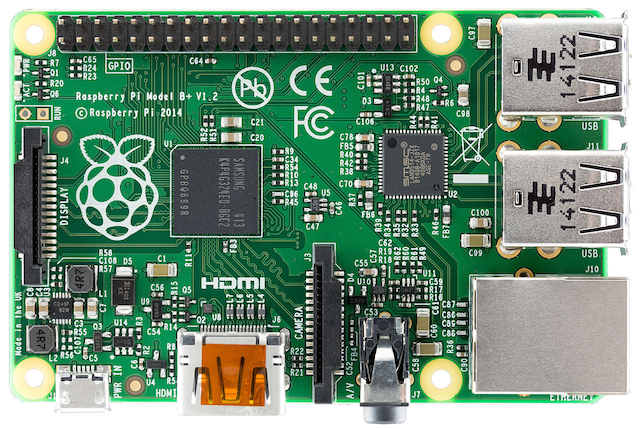
Today, I would like to list some interesting developments in open instrumentation. Also, I want to drop a quick note on the Guinier prize of this year’s SAS conference: if you did not nominate anyone yet, how about nominating me?
Guinier Prize
Perhaps a small justification for such hubris may be in order.
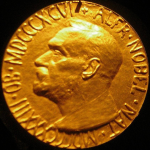
There are many great small-angle scatterers out there to nominate for the Guinier prize (nominations open until April 30). For example, you can consider nominating Jan Ilavsky, Adrian Rennie or Jan-Skov Pedersen, to name but a few. And initially I did considering naming such choices. But whomever I considered, there were others equally worthy of the prize, and I could not possibly consider endorsing one thus ignoring the others.
After struggling for a while, the only “neutral” option I can consider is me. So I hereby offer my candidacy: if you have enjoyed the LookingAtNothing site or my work, and think it has been an “outstanding contribution”, please be so kind as to nominate me for the prize. The information you need for this nomination can be found on this site (“about me” contains my CV, and “publications” lists my publications).
With the prize I will be able to improve the work and outreach efforts. It allows, for example, development of better printed instrumentation and explanation tools (a standalone live Fourier Transform education tool, for example), get better equipment to record videos, and the award makes giving presentations easier (it is easier to justify inviting people with awards). In short, the prize can be used to make small-angle scattering bigger!
Printing your own laboratory
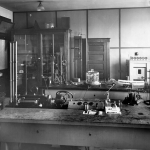
I have come across quite some articles in the past few weeks of people building some laboratory instrument by themselves (in order to cut cost, for societal benefit or philosophical reasons, or to explore instrument development). It has become easier to do so with a rapid increase in inexpensive open hardware (control electronics, measurement devices), 3D printing, and a lower threshold for programming.
There are now enough such projects around that one can build a (near-)complete laboratory on a small budget, given enough students and some time. Such laboratories are excellent options for universities and institutes in developing countries to expand their instrumentation, but also for “rich” institutes to lower the threshold of use and increase availability. Furthermore, by building, students and researchers can learn better how their instruments work, which helps to understand the way instruments can fail and fool.
To highlight the breadth of some of these efforts, here are some projects I came across. Let’s start with the hardware that forms the core of much of the combined instrumentation.
HARDWARE:
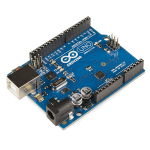
- The Arduino: an open, easily programmed microcontroller with a few analog and digital inputs and outputs. For this board, many “shields” are available: plug-on modules enabling various custom functionality. I have used one before as pulse counter and ratemeter. Cost: about 30 Euro.
- The Raspberry Pi 2:
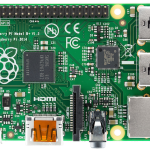
A Raspberry Pi 2. CC-licensed image from Wikipedia. a small, yet full-featured Linux computer I am just getting started with. Very capable of running the Python programming language, and much help is available online due to its popularity. This will probably replace my ageing Mac Pro for Ultra-SAXS instrument control soon. Cost: about 40 Euro.
-

A red Pitaya. CC-licensed from Wikipedia. The Red Pitaya: an open data acquisition device (much faster than the Arduino or Pi), can be used as 50 MHz oscilloscope, signal generator, spectrum analyser, etc.. Cost: 375 Euro (at RS-components). This may in the future replace the aforementioned NIM-duino, and take on more tasks such as peak profile analysis (working as an advanced discriminator).
LAB EQUIPMENT:
The aforementioned hardware can be combined with custom pieces, printed cases and some other off-the-shelf components to build some amazing instrumentation:
- A Raspberry Pi-controlled, 3d-printed Raman spectrometer: the RamanPi. Git repository with all details here. More details here. Estimated cost: $600 – $1000.
- Much more straightforward, but still fun: A UV/vis spectrometer (though details are sparse as of yet), approximate cost $100.
- More spectrometers: a colorimeter (publication here)
-
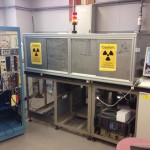
The Ultra-SAXS machine. Now getting some initial results. My own Ultra-SAXS instrument (second version), introduced here. Estimated cost: about 30000 Euro without X-ray source (price to go down with future improvements).
- The Open Microscope: an automated, good laboratory microscope.
- The open Quartz Crystal Microbalance. A tiny microbalance, with a 3D-printed case and an Arduino microcontroller board for control. Cost: 400-500 Euros.
- Safecast: an open design, GPS-enabled radiation monitor, designed after the Fukushima disaster. Cost: $450 (Amazon).
- But the list is larger than I expected, there are centrifuges, syringe pumps, telescopes, and much, much more.
DRAWBACKS:
So now the downsides to these efforts.
Firstly, there is much less support than one would get buying an instrument from a company. Some of these projects are short-term projects or reliant on community efforts, and any help may therefore disappear sooner or later.
Secondly, building instruments is not a quick effort (no matter how easy it might seem), and such projects should therefore be led by people on exactly those long-term contracts which are becoming exceedingly rare in the “metrics-driven” institutes.
Lastly, there are few accolades for building common instruments, which will not help boost your “metrics” in any way.
SO?:
However, I can personally attest that it is fun and at least personally rewarding to build an instrument by yourself. Building means you learn a lot of new things and skills, which a noble goal in and of itself.
Secondly, you can take it easy if you have the time. My instrument took a while to build, but I was not at it all the time. I have spent about 10-20% of my research time over the last few years building it: whenever I felt stuck in whatever I was doing, I could go to the lab and (re-)build something.
And now I feel I can build amazing robotics with my kid later in life. And that may be worth something too.

Nice try to promote yourself. I grant you that.
Too bad that a science blog provides no free goodies like a life style channel on YOUTUBE. I will admit this.
But how about trying out crowd funding or convince companies to provide free equipment for a good purpose?
Since you asked for a vote, please answer: Why exactly it has to be YOU who will make small angle scattering bigger and not the mentioned names above?
After all, you could nominate yourself, I guess.
Hi Paul,
Thanks for the comment, let me start answering the questions starting from the last.
Many of the other small-angle scatterers I know are doing their best to promote small-angle scattering in their own way, and each and every one of them deserves respect. Any prize as such is inherently unfair by highlighting one over the other.
However, awards have enhanced benefits to the scientific career of early career researchers in particular. Awards help open up funding sources to support students and equipment, and signify trust in the efforts of the researcher (allowing them to work with more freedom). They also make it easier for others to invite said researcher for speaking opportunities or collaboration.
So to answer that last question: the benefits of a prize awarded to me would likely make a larger impact than when it is awarded to a more senior colleague. And while I am not senior yet, I do have an established and continuing record of outreach through the LookingAtNothing site (and accompanying Youtube channel), occasionally culminating in publications for that long-lasting academic output.
Now for the first question: how about crowd funding or company support? As you indicate, I am not getting money from Youtube (I decided against showing commercials to the viewers). Crowd funding would be possible, and I have thought of setting up a Patreon. However, crowdfunding relies on the provision of “bonus” material to backers, and at the moment I am at a loss what potential backers would like to see.
Company support or advertisement is another option. I do have contact with some companies, as demonstrated when analysing the dense silica spheres data provided by Xenocs. However, I am worried about (ostensibly) biased articles appearing on the site. At the moment, I have all the freedom I need to criticise e.g. Rigaku, Anton Paar or Bruker, but this may go out the window once a sponsor arrives (a situation such as in Japan must be avoided, where every news article is vetted by the advertisers). Furthermore, when I ask the question: “what is in it for them?”, tangible benefits besides an ad or two are difficult to promise.
I also asked Dectris whether they would accept a kidney for a Pilatus detector, but they refused.
Anyway, thanks for the helpful comments, we will keep an open mind here!
Cheers,
Brian.